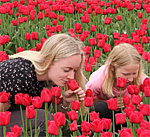Biochar – How Does It Work?
 Special to Road Trips For Gardeners
Special to Road Trips For Gardeners
By Susan Fisk of Soil Science Society of America
What can be made with unwanted materials, looks like charcoal, and provides multiple benefits to soil health? Biochar. This “charcoal sponge” is a valued tool to deal with soil issues.
Biochar – as the name implies – is made from formerly living substances. Source materials can be plant materials like leaves, stems, and woody tissue. Biochar can also be made from manure, or even biosolids (the solids left after wastewater treatment). Biochar is the material left over after burning one (or more) of the above items in a low- or no-oxygen environment.
“Think of it like a charcoal sponge,” says Jim Ippolito, Colorado State University. “This large surface area can hold a lot of chemicals and toxic metals, making it quite valuable.”
The addition of biochar to problematic soil can have positive results:
It can be a nutrient source for helpful soil microbes.
It can improve soil texture and allow for better water filtration.
Biochar can trap other chemicals in the soil, such as pharmaceutical wastes.
It can also reduce metal toxicity, allowing more plants to grow in places such as reclaimed mining areas.
You can read more about biochar online.
The Soil Science Society of American (SSSA), founded in 1936, is an international scientific society that fosters the transfer of knowledge and practices to sustain global soils. Based in Madison, Wisconsin, it provides information about soils in relation to crop production, environmental quality, ecosystem sustainability, bioremediation, waste management, recycling, and wise land use.
(Photo courtesy of Soil Sciences Society of America)








